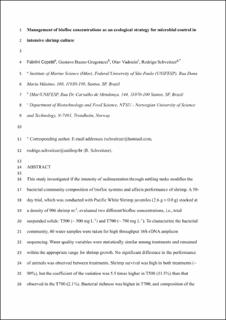| dc.description.abstract | This study investigated if the intensity of sedimentation through settling tanks modifies the bacterial community composition of biofloc systems and affects performance of shrimp. A 50-day trial, which was conducted with Pacific White Shrimp juveniles (2.6 g ± 0.0 g) stocked at a density of 906 shrimp m−3, evaluated two different biofloc concentrations, i.e., total suspended solids: T500 (~ 500 mg L−1) and T700 (~ 700 mg L−1). To characterize the bacterial community, 40 water samples were taken for high throughput 16S-rDNA amplicon sequencing. Water quality variables were statistically similar among treatments and remained within the appropriate range for shrimp growth. No significant difference in the performance of animals was observed between treatments. Shrimp survival was high in both treatments (~ 90%), but the coefficient of the variation was 5.5 times higher in T500 (11.5%) than that observed in the T700 (2.1%). Bacterial richness was higher in T700, and composition of the bacterial community was different from that of the T500. We argue that a higher intensity of sedimentation, which decreased the TSS level in the T500, promoted changes in the microenvironment of these tanks. This, in turn, affected the ecological state of the system by destabilizing the bacterial community and promoting proliferation of opportunistic species (e.g., Vibrio) in tanks with lower floc levels. The higher presence of opportunists is likely related to a reduction in microbial carrying capacity (CC) and an increase in substrate supply per microbial cell promoted by the higher floc removal. Under such conditions, fast-growing opportunistic r-strategists are favoured because they perform better in uncrowded environments with high resource availability per cell. Conversely, tanks with higher floc levels, closer to the CC, and thus with scarcer resources per cell, result in strong competition and selection of slow-growing competition specialists - the K-strategists. In conclusion, our results show that the control of floc levels can be an important strategy to obtain bacterial control and should be considered in management practices. | en_US |

